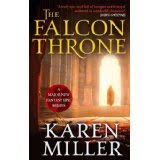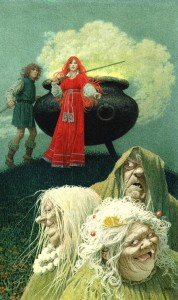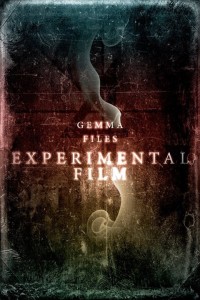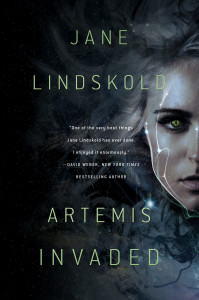 Karen Miller was a spec fic fan long before she started writing her big fat fantasy novels. There’s every chance you’ll find ‘Scotty Beamed Me Up’ on her headstone once she’s gone. Right now she’s working on the 2nd book in her ‘The Tarnished Crown’ epic fantasy series.
Karen Miller was a spec fic fan long before she started writing her big fat fantasy novels. There’s every chance you’ll find ‘Scotty Beamed Me Up’ on her headstone once she’s gone. Right now she’s working on the 2nd book in her ‘The Tarnished Crown’ epic fantasy series.
Book 1, ‘The Falcon Throne‘, is on sale now in hardcover and paperback.
Is there a literary heroine on whom you imprinted as a child?
Casting my mind back to the dim, dark past of childhood … there are several female characters with whom I formed a strong bond. Lucy from the Narnia series, Norah from the Billabong series and Anne of Green Gables.
You’re the second person to mention Anne! Can you remember what it was she, Norah and Lucy did or what qualities they had that captured your affections and your imagination so strongly?
Lucy was in the first proper fantasy novels I ever read, when I was around eight. I loved her because she was brave and steadfast and she stuck to her guns even when her siblings doubted and mocked her. Norah Linton, from the Billabong series? Probably readers beyond Australia have never heard of these books, but they’re pretty remarkable. They’re set in country Victoria prior to world war I, start with Norah in school and follow her life through to adulthood, marriage, having a child. While being very much of their time, Norah is never victimised or second-classed because she’s a girl. She’s courageous, loving, compassionate and honourable. She lives on the land, with all the challenges that contains, does war work in London, has adventures. Her mother’s dead but she has a loving father and brother and her brother’s school friends, all of whom treat her like a person first and foremost. She’s an animal lover and so am I, and to this day when I re-read the series there are books or parts of books that I can’t read because the author doesn’t sugarcoat life on the land and it’s genuinely distressing!
Lastly, Anne of Green Gables. Again, these are books of their time so some things need to be read in context, but even so — Anne is a rocket. Fearless, determined to be herself no matter the opposition, a passionate lover of books and believer in the power of the imagination. These three heroines spoke – and to this day still speak – to parts of my soul and provide hope that it was and is okay to be that kind of person.
How does she compare to the female characters in your work? Is she their literary ancestor? Do they rebel against all she stands for? What might your creations owe her?
Interesting! I’d never thought about it but in a sense these characters have strongly informed some of the female characters in my work. I try not to write any character as strictly a hero or a heroine. While some people end up with more ticks in the ‘good guy’ box, rather than the ‘bad guy’ box, and vice versa, I believe we are all of us a mix of good and bad and on any given day, faced with a particular challenge, one side or the other is going to win out in how we deal with it … and it’s not always the side we want, or that society wants. Also, characters will interpret themselves and their choices in the most favourable light – as we all do! – so while they see themselves as heroic, the objective observer – and other characters – see the opposite. And, as I said, sometimes we act heroically in our lives and sometimes we do take the easy or the dishonourable or the coward’s way out … and usually my characters do both at some point, depending on the circumstances. Even my villains do the right thing now and then! But those heroines I fell in love with as a child certainly have helped me to shape my own understanding of what makes a person heroic, at least for me, and that understanding informs my writing to this day.
How do you feel about the word heroine? In these posts, I am specifically looking for female authors’ female influences, whether those women they looked up to were other writers or Anne of Green Gables. Does the word heroine have a purpose that isn’t served by equally well by hero?
Hmmm. Hero/heroine — it’s one of those gendered differences that carries so much baggage. What a male character might do that’s seen as heroic is often likely to be condemned when done by a woman. The different expectations/standards attached to men and women in most of the world’s societies persist and inform opinions on what makes someone heroic. I certainly think of those 3 favourite female characters as heroic – and by extension, their creators, 3 great female authors. In many ways they managed to create heroic girls who weren’t simply fake boys. They shared some characteristics with ‘male heroism’, but in other ways they were great young women in ways that only a woman can be. Too often, these days, female heroes are simply men with boobs. The element of empowered femininity has been stripped away, which isn’t good.
There are certainly ridiculous elements to dramatised heroines. If she’s not Buffy with supernatural powers your average woman is not going to take down a strong, fit and trained man. Girl power only takes you so far. I guess what I’m trying to say is that the genuine and legitimate differences are physical, not ephemeral. Qualities of character are unisex – courage and honour are not gendered (though there is a subset of the male population that would like us to believe they are.) Likewise unheroic acts aren’t gendered although, again, there are some folk highly invested in making us think they are. That’s what comes of raising boys as primarily defining themselves as not-girls, with all the gendered bias and stereotyping that entails. On this score, I’m not sure it’s possible or even desirable to eliminate the female version of ‘hero’, for either gender. But we do need to make it very clear that some acts will always be heroic, no matter which gender performs them.
_______
About this post: The Heroine Question is my name for a series of short interviews with female writers about their favorite characters and literary influences. Clicking the link will take you to all the other interviews, with awesome people like Charlene Challenger, Gemma Files, Caitlin Sweet, and Jessica Reisman.
Also about this post: As I have mentioned, writer Alex Bledsoe recently asked about my use of the gendered word, heroine, in this series. I could have gone with hero, true, or “female heroes” since I was looking for women authors’ female influences. To be honest, my initial inspiration came from my ever-mature desire to make tacky-sounding drug jokes: Gemma Files on Heroin! Oops! Heroine! That kind of thing.
I hope to get up a post that takes the answer further than “I pun, therefore I am.” And I have folded a question about this word into the later interviews; you can see Karen’s answer here.






